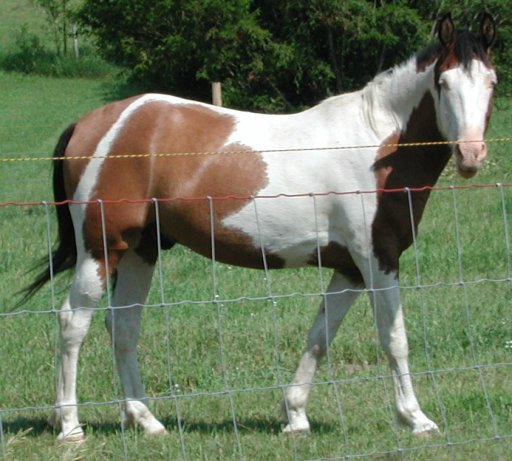Back when horse stories dominated my library, a piebald was black and white pinto; and a skewbald was a color not black (presumably brown of some sort) and white. Particularly intriguing was the idea of a brown, black and white splotched paint, colored like a calico cat. Alas, my current researches lead to believe those don't actually exist. My dearest posessions were horses to fit 11” dolls—Thunderbolt and his ilk, made by the Louis Marx company—I not only had Johnny West but Jane (which my mom thought a hideously ugly doll) but my real loves were the horses; I had the standard ones; the jointed ones, even the ones with little wheels in their hooves, that you could (theoretically) roll along the floor.
This last was actually a medieval knight's horse, which came in a sort of rusty red I've never seen on a real horse. The gold and silver plastic armor was cool, the plastic western gear less so. I went through at least two of the red knight's horses: the first fell apart from being taken into the bathtub: I still can see the water draining out of its seams, as I held it up... I recall purchasing the (second?) one: it cost about three dollars, and a I spread a pile of change on the counter to pay for it myself. Big Red (nee Bravo) was the king of my herd and so he remains today; Thunderbolt, the palomino, his Queen.

One of the few photos I have that comes in a larger version. Given the smooth patches with white face, perhaps a tovaro? Jun 2004, Michigan
I wouldn't have anything to do with Barbies, so my mother said: I just substituted “those horses” instead: in addition to painting them, I also used to dress them up in fur trimmed velvet outfits and copper jewelry I made myself. (The human dolls served only to be the horses’ ‘slaves’. Despite a liberal upbringing I was not a particularly kind, thoughtful or enlightened child.) By the time I graduated to Breyers, because of the greater versimilatude, which even then were awfully expensive for a child, my interest was already petering out: I had discovered books—first animal stories, briefly interleaved with Nancy Drew and the Hardy Boys, then science fiction (with fairy tales all along, of course;)
Turns out, like everything else on this internet connected world that there are other collectors out there; and a while ago (at least two years ago) I decided to see what was up with Breyer model horses; and oh my goodness, that world has taken off, with all sorts of people not only doing elaborate repaints, but sculpting the models from scratch, not to mention making elaborate tack—even tasseled costumes! That looked like so much fun, so I decided to start collecting reference photos. (Though I couldn't help a deep sense of irony when I discovered a repaint site for Marx horses that most particularly desired the potential customers to understand these products were not toys. Unlike breyers, which have always catered to the collecting crowd [though to be sure people play with those too] the marx product was never intended to be anything else, and my horses, repaints or not, most certainly were toys. Indeed I would wager most of this woman's customers are adults with a nostalgic fondness for their childhood toys.)
What I have so far, you see below; I have yet to do any repaints (for one thing my horses on long-term loan to my sister) though a couple of months later I discovered OOAK dolls, and I have plenty of material for those (and still haven't done any repaints or costuming). But some day... —and in the meantime, here are some reference photos—not great, but having a lot of variations has got to be helpful, no?
The modern terms divide the patterns on the basis of the shape of the color, rather than what color it is, and there are a number of terms, the most basic being ovaro and tobiano. There are a number of variations on these themes, including the combination tovaro. I'm not enough of an expert to say which is which with confidence, but you can read all about it in this excellent summary of paint horse genetics; see also the introduction. The first link has a description and photo of each type.

this photo included for compartive purposes—note the way the spots, particularly the one ahead of the hip, have changed in angle from the above.
file created 25jun06
Unless otherwise noted, text, image and objects depicted therein copyright 1996--present sylvus tarn.
Sylvus Tarn


